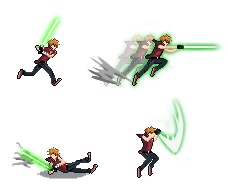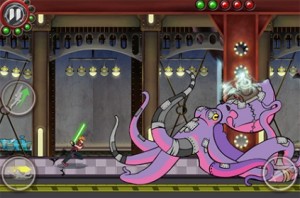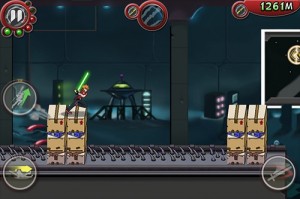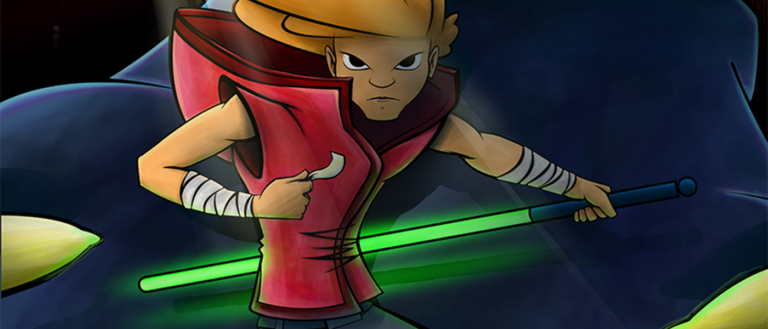 Once you decided on a running game as your next title, why did you adopt a level-based design with character upgrades, boss battles, the works, when much simpler games have already achieved great success on iOS? What made you take a leap of faith that the market would be ready for something a little more complex in the running genre?
Once you decided on a running game as your next title, why did you adopt a level-based design with character upgrades, boss battles, the works, when much simpler games have already achieved great success on iOS? What made you take a leap of faith that the market would be ready for something a little more complex in the running genre?
It was not planned to have so much depth at first. That said, one of our interests as developers is to push concepts as far as possible, so the project kept evolving with time. The first big innovative design aspect to enter the project was character upgrades. We saw how much fun this was in other games, so it looked like a good idea to implement it as a runner and give it an RPG twist. While working on the skill trees, we stumbled on the dive action (mapped to the slide button while in the air) and the dash action (mapped on the attack button while in the air).
At this point, the possibilities literally exploded. We realized that those two actions, along with the double jump upgrade, gave enough control to the player to navigate in very complex gameplay environments. That’s how we managed to introduce such a wide variety of level configurations, almost transmuting a running game into a platformer.
The rest fell into place gradually. We eventually decided to have a story mode with fixed progression in addition to the endless random mode. From there, the boss battles, which we had put on hold because of the amount of work they implied, became a must in order to give even more distinction to the game. Adding comics completed the story mode experience.
So we got caught-up a bit in the process, but in the end it made sense. By trying to push back the boundaries of the running genre, we tried to keep things interesting for ourselves and the gamers. At first we were targeting more traditional players, but over time we noticed that the game could interest a broader audience. So toward the end, we smoothed the first half of the game as much as possible. We think that the final product is quite challenging and entertaining for hardcore players, yet accessible to more casual players.
 One thing we didn’t get a chance to try out in the preview build are DRWAPS’ boss battles. What nasty creatures and contraptions will the player duel with in the final, and what’s the hardest part of designing a good boss?
One thing we didn’t get a chance to try out in the preview build are DRWAPS’ boss battles. What nasty creatures and contraptions will the player duel with in the final, and what’s the hardest part of designing a good boss?
The boss battles are meant to provide the player with gameplay variation and a sense of climax or accomplishment. They represent only a small portion of the game in terms of play time, yet they involve a lot of work. From a technical, art and design point of view, they’re made up only of exceptions and particular cases.
A difficult aspect was to work with the limitations of the running game structure. The player can’t move freely, so the boss must come forward and be defeated through the same actions that the player usually has. We could have changed the game mechanics against bosses, but this probably would have been confusing to the player. Another difficult aspect is balance. The experience has to be challenging but not frustrating. A third challenge is clarity: the player has to be able to understand or “read” the planned moves and patterns of the boss naturally.
As for the selection of bosses, instead of going for profound meaning in the context of the story, we simply tried to keep the artistic and humorous direction. The first boss is a large flying saucer dropping meteors on the player and teleporting baddies to the ground. The second boss is a giant robotic octopus with a laser cannon attached on his back (sharks with lasers, beware!). The third boss is a giant robotic serpent madly rushing the player. The last one, but not the least, is a large armed robot with a cockpit, driven by one of those pesky yellow aliens.
 Should we expect a Lite version of DRWAPS at launch? What do you think of Lites in general – do you view them as a major sales driver, or does their major usefulness lie in less tangible things, like serving as a signal of goodwill to customers?
Should we expect a Lite version of DRWAPS at launch? What do you think of Lites in general – do you view them as a major sales driver, or does their major usefulness lie in less tangible things, like serving as a signal of goodwill to customers?
At this point there is no plan for a Lite version. What we do about that will depend on the players’ response.
From our experience and to our knowledge, Lite versions usually don’t help the main game very much. Yet, they still provide a way to establish a contact with the players. The Lite versions that seem to work more consistently are for pricey AAA products or for already super-popular games. The freemium model can work more easily, but gamers are still a bit uneasy about it and with the number of developers rushing for this model, the free market is going to be overcrowded soon.
There are IAPs in DRWAPS, but they are meant for people wanting to speed up their progress. Everything is accessible to the player with the basic version, and we’d like to keep it that way even in future updates.
Big thanks to Patrick Jacob at XperimentalZ Games for taking the time out to answer our DRWAPS questions while the studio’s busy wrapping up this exciting project! Don’t forget to check out our hands-on impressions from September, as well as the developer’s website and Facebook and Twitter accounts, while waiting for the game to launch on November 30.


